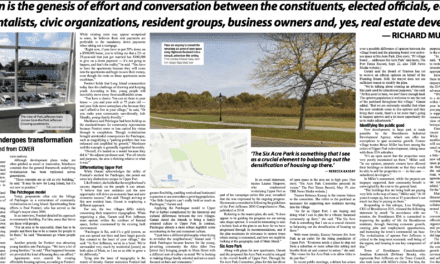For decades, the pattern was the same: Find a plot of vacant land, raze it and put up a new subdivision of pristine single-family homes. Rinse, repeat ad infinitum.
Then suddenly, the recession hit. The housing market bombed. Construction-starts in both Nassau and Suffolk counties froze, and the real estate industry treaded water (if not temporally drowned). In post-recession Long Island, the single-family home was no longer economically viable, for they weren’t being built or bought, and the market was oversaturated with foreclosures. It seems that from the ashes of the recession sprouted a new fiscal flower for developers – multifamily dwellings.
How convenient that in recent years, it was determined that our region suddenly needs more multifamily housing, just as single-family construction ground to a halt. If our development pattern has been consistent for the last 50 years, why, all of a sudden, do we need to “plug the brain drain” with more apartments? Shouldn’t we have been pursuing multifamily growth in the 1980s and into the 1990s? Why is there a push for multifamily units now?
We’ve always needed to diversify our housing stock, but the market demanded single-family homes. Like any smart business would do, developers took the path of least resistance to fiscal sustainability. Single-family residential units were getting approved as fast as subprime mortgages, so we now have the current lopsided balance of housing choice.
What is inherently frustrating is how these overarching market trends don’t seem to get mentioned in the litany of work in the last decade on Long Island’s housing needs.Thinkers, pseudo-planners and so on all pontificate about Long Island’s need for multifamily housing and rentals, without making mere mention of the fact that if the market suddenly demanded single-family homes again, multifamily construction would be abandoned in a heartbeat.
Developers choose what will be easiest to build in a difficult market (Long Island’s residents aren’t exactly open to change), and what will yield the most profits for their effort. This is the way it should be; it’s capitalism. Businesses should pursue their bottom line. That’s why they can’t be driving land-use policy.
This is where urban planners step in. Armed with data, driven by facts and professional standards, planners can study regional issues with a healthy detachment from a developer’s profit motives. This allows for what’s best for the region to craft recommendations, not pursuing policies that benefit vested interests or agendas. True planning is driven by community input, and shaped by both environmental and observed data. Planners work with special interests to process their expertise, and craft visions that incorporate regional needs and propose solutions that balance economic, environmental and social forces.
Here on Long Island, there is the rather inconvenient truth that our sole-source aquifer can only handle so much growth. Despite claims to the contrary, no amount of sewers or downtown redevelopment can protect our drinking and surface waters as well as open space preservation. We’ve already seen degradation in quality, and that’s reflective of development patterns staggered twenty years ago. Like it or not, we have a carrying capacity. We must work within these environmental confines.
What’s dangerous is when private industry stakeholders pose as legitimate urban planners. Even more so, is when these stakeholder voices steer the conversation regarding our regional needs, and influence policymakers to cater to their needs. Why are nonprofit organizations that are financially supported by developers shaping our housing and development policies? Further, why aren’t planning standards strictly adhered to? It’s up to the public to be critical of surveys and studies that claim to study regional trends.
In marketing, it’s often said the loudest voice is the one that gets heard. Unfortunately, that rings true in land-use policy as well. As I’ve written before, the system continues to be broken because we allow it to be. We need strong, detached leadership that puts Long Islanders first. If vested stakeholders are driving the process, we shouldn’t be surprised when their solutions are vested as well.











